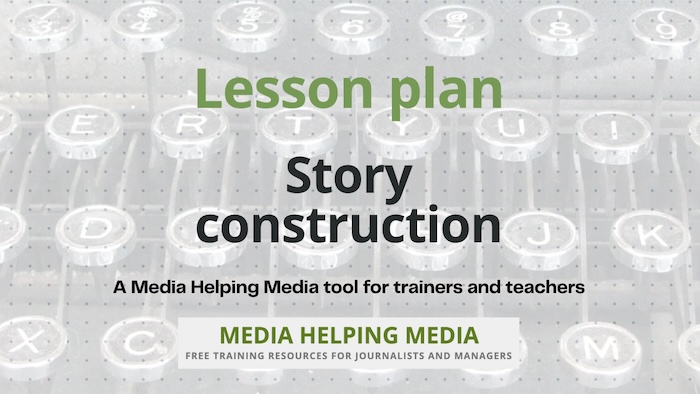
Piecing together a news item without a story plan is a bit like trying to build a construction kit without the instructions. You might have the information you need for your report, but you will need a plan for how to put the elements in the right order so that they make most sense.
This training module was written for young journalists working in rural Zimbabwe. Once they mastered the skills of story construction it became second-nature and they automatically applied the steps set out in this article.
Having an outline indicating where each element fits will help you see what information you might still have to find. A plan will also help you see what your news report should look like when it is complete.
Knowing what you still need in order to finish your report, where to find those elements, and where to fit them into the story, is a challenge all journalists face when starting off in journalism.
You might have a great story idea, and you might already have one really good interview, but what parts do you still need to make the story complete? And what angles do you still need to explore to make it as powerful as it could be?
Talking to a colleague could be helpful. It might be another journalist who you choose to bounce your ideas off, or it might be your editor or a news producer.
So first you need a story, then you need a story plan, and then you need to find all the parts to make the item work.
Building the framework for your story
Before you include others, sketch out a framework for your story so that you have something to discuss.
Start with a blank piece of paper.
In the middle, jot down the main event or fact that has inspired your story idea. Draw a circle around it.
Let’s look at an example.
You might be covering a story about women in Matopo, Zimbabwe making jam in order to help their families and community survive the economic impact of the drought.
This is one of the many videos produced by The Mobile Community Zimbabwe – an initiative designed to help young people – many of whom were taking their first steps in their journalistic career – report on stories in their local communities.
Let’s take a look at how a story plan might help enrich and develop the story they produced (embedded below).
This story includes some great pictures. We have video of the women growing fruit, harvesting it, preparing it, and making jam, and we see the process through until the jam is bottled and ready for market.
The journalist creating this video has also gathered some excellent interviews with three women, one has a husband who is out of work, another has a husband who doesn’t earn enough to support the family, and there is a grandmother who is using the jam-making initiative to pay the school fees for her grandchildren.
But there are so many more facts that we could include if we had a story plan.
Try jotting these down in circles around the main story idea on your piece of paper. Such ideas might include:
The jam
- The cost of making the jam – where do they get the fruit? How long does it take to produce? What about the sugar, water, and the power required to cook the jam? What about the cost of the jars?
- The profit margin – the price of a jar of jam is $1, how much of this is clear profit? How is the money shared among the women?
- Selling the jam – where is it sold? Do they have to take it to market? How do they get it there? Are they supplying shops or individuals?
- The quality of the jam – how about filming some people tasting it? Perhaps the local children could be treated to jam on bread and then interviewed giving the jam marks out of 10?
- What about the nutrition angle? Is the jam a better product for selling than, say, dried fruit? What alternatives are there? Is it worth talking to a nutritionist?
The poverty and hunger angle
- The video commentary reveals that the jam making initiative is part of “a fight against poverty and hunger” in the community – so what impact has it had? And what other initiatives are being introduced? Here we could do with some data.
- What was the situation before and after the jam making initiative? How big an impact has it had on raising revenue? Are there any projections about how much it could help?
- How big is the community? What is the poverty level? How does Matopo compare with neighbouring towns and villages? Is it worse off or better off, and why?
- How does the situation in Matopo compare with the rest of Zimbabwe and regionally across Africa?
- As always, a map would be good. Of course many local people know where Matopo is, but even those who are familiar with the location like to see a map of where they live when they are watching a video or reading an article.
Male income and unemployment
- We discover from the piece that one husband is out of work, and that another doesn’t earn enough to feed the family (and has to be supported by the income from this community venture). Here we could try to find out more about the income of a working man from Matopo who travels to the city, his daily income and his daily costs. What is the average wage in the area?
- We could hear more about the unemployment problem. What is the unemployment figure in the area?
- We hear that one woman is widowed. What is the life expectancy for men in the area?
Setting an example
- The piece includes an interview with the local MP who tells us that he is keen to support the initiative. We need to find out how he intends to do this.
- Does he think it is a model that can be copied by other communities?
- Will there be financial help for the women?
- Will they become mentors for others who wish to follow their lead?
- What government grants or help are available for those wanting to start their own community cottage industries such as the jam making initiative?
- Are there any government quality-control issues with the production of home-made jam?
- Do they need a licence to sell?
You now have a story plan
You probably won’t want to follow up all the angles mentioned above. You might want to put some of the ideas in a diary with a follow-up date so that you can continue to expand on the issues raised in a series of reports.
The value of this exercise is that you think through the possibilities, discuss them with a colleague, and develop a story plan.
Having a plan will help you prioritise your effort and focus on the most important elements.
It will bring all the angles of the story together in a way that makes sense and leads to a logical conclusion.
It will help you explain the issues related to the story better, it will help enrich your story, and it will help you in your task of informing the public debate with original, in-depth journalism about the issues that are affecting the community you cover.
See our training module on story development.
What happens next?
With any story like this it’s worth having a follow-up date. It might be that you simply jot down a day in, say, three or six months time when you will revisit the story to see how the women are progressing. This will provide you with a valuable follow-up piece.
When you come to revisit the story you will have the archive from the original story, the hopes and expectations of the women producing the jam, and any promises made by the MP.
In three to six months you can measure what has developed against what was expected.
See our training module on forward-planning.
Social media sharing
You will obviously want to share your story on social media via YouTube, Facebook, Twitter and any other popular social media network used by your target audience group.
This is where you need to promote your story, not just share it. Tell people WHY they should watch your video.
Create ‘compelling calls to action’ such as “see fruit turn into dollars as women tackle poverty with jam”.
And then monitor the social media responses to your story and, if possible, weave them back into any follow-up stories you create.

Questions
- What is the primary purpose of a story plan in news article writing?
- Why is it important to have an outline when organising the elements of a news story?
- Identify two challenges journalists face during the news production process.
- How can discussing your story ideas with a colleague benefit the news production process?
- What are the three main steps for creating a successful news article?
- Analyse how the lack of a story plan might affect the quality of a news article.
- Evaluate the role of an editor or news producer in the development of a news story.
- What is the best strategy for avoiding producing an incomplete news report?
- How can you ensure that all necessary parts of a story are included?
- Discuss the potential impact of exploring different angles in a news story.
Answers
- To ensure all important pieces of information are included and the report is complete.
- An outline helps determine the order of elements and ensures nothing is left out.
- Knowing what elements are still needed and where to fit them into the story.
- It provides feedback and new perspectives, which can enhance the story’s quality.
- First, find a story; second, create a story plan; third, gather all necessary parts.
- It may lead to missing important information and result in an incomplete report.
- They provide guidance, feedback, and help refine the story to make it more impactful.
- Develop a detailed story plan, seek feedback from colleagues, and continuously review the story’s completeness.
- By having a story plan and consulting with colleagues or editors.
- It can make the story more comprehensive and engaging, potentially reaching a wider audience.
Lesson plan for trainers
If you are a trainer of journalists we have a free lesson plan – How to create a structured news report which you are welcome to download and adapt for your own purposes.
Related training modules









